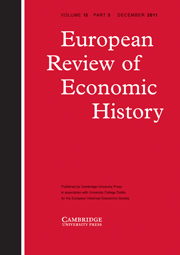Article contents
Convergence in the age of mass migration
Published online by Cambridge University Press: 07 September 2006
Abstract
Between 1870 and 1913 economic convergence among present OECD members (or an even wider sample of countries) was dramatic, about as dramatic as it has been over the past century and a half. What were the sources of the convergence? One prime candidate is mass migration. This paper offers some estimates which suggest that migration could account for very large shares of the convergence in labour productivity and real wages, though a much smaller share in GDP per capita. One might conclude, therefore, that virtual cessation of convergence in the interwar period could be partially explained by the imposition of quotas and other barriers to migration.
The exportation of labourers and capital from old to new countries, from a place where their productive power is less to a place where it is greater, increases by so much the aggregate produce of wealth of the old and the new country.… Colonization, in the present state of the world, is the best affair of business, in which the capital of an old and wealthy country can engage.
–John Stuart MillMill (1929 [1848])
It must be emphasized that without the change in the proportions of the factors of production that occurs as a result of migration or population growth, differences in factor prices in various countries will persist, and the factors of production of the world as a whole will not be used to their best advantage.
–Eli F. HeckscherFlam and Flanders (1991, 59). Heckscher understood that with impediments to trade or with specialization outside cones of diversification (a failure of ‘harmonic equilibrium’, in his words), factor price convergence would be incomplete and factor migration necessary to obtain factor price equalization.
- Type
- Articles
- Information
- Copyright
- Cambridge University Press 1997
- 101
- Cited by


